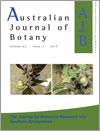Australian Journal of Botany
Volume 62
Number 3 2014
As climates change, forests must move, adapt or die. During ice ages, drought- and frost-resistant trees, such as Eucalyptus pauciflora, could have toughed it out on freezing highland savannas, but we show that they are more likely to have taken refuge in warmer lowland areas, expanding their range back into highland areas as the climate warmed, with pollen dispersal promoting a diverse gene pool in the new colonies. This is the first study to provide evidence to inform the debate about whether E. pauciflora survived glacial periods in highland areas.
We investigated ecological control of invasive mission grasses by a native acacia. The allelopathic and physical effects of leaf litter on germination, emergence and growth of mission grass seedlings were studied. We found a physical impact of dense A. holosericea leaf litter on emergence, and a mild allelopathic effect on seedling root growth. These findings will assist in rehabilitation of disturbed sites.
The eucalypt species eaten by koalas are often unpopular with urban landowners and councils because of perceived dangers from falling limbs. We aimed to develop shorter eucalypt trees for urban areas by grafting tall species onto short species. Grafting success was greatest between closely related species but grafting rarely provided a suitable combination of high tree survival and low tree height. However, grafted Eucalyptus moluccana/E. behriana trees showed potential for urban amenity and fauna habitat plantings.
Understanding environmental factors such as soil temperature on the growth of Acacias and Eucalypts is crucial to predicting how these Australian plants may adapt to a changing climate. We exposed the golden wreath wattle and the bushy sugar gum to warm soil during spring and development was compared to two North American deciduous species. We found that the Australian evergreens had unique patterns of carbon and nutrient partitioning between the below- and aboveground portions and therefore they are likely to have distinct growth responses to a changing climate.
Given the horticultural significance of double flowers, they have been the subject of many developmental studies. We aim to address the question about the developmental process underlying the formation of extra petals in polyandrous flowers of Alcea rosea. The double-flowered phenotypes of Alcea appear to fit the criteria for homoheterotopy as well as for neoheterotopy.
Dendrobium officinale (Orchidaceae) is an endangered Chinese traditional medicinal plant. We examined the cell structural change of D. officinale seed inoculated with mycobiont Sebacina sp. and found that the colonisation by fungal hyphae, and peloton formation and digestion are associated with protocorm development. The result indicated symbiotic germination technique is a potential effective way for conservation and application of endangered orchid Dendrobium medicinal plant.
Due to the disagreement and inconsistencies which have existed among taxonomic classification of Onobrychis genus, we used morphological and molecular phylogenies to analyse ITS and trnL–trnF sequences of 76 species, so as to investigate and obtain a deeper intuition of the general structure of the interspecies relationships in Onobrychis.
The study of chromosomes can help to understand the relationships among related species or clusters of species. Deprea and Larnax have been controversial about their position and classification within the nightshade plants family; besides, their chromosomes have still not been studied. We described for the first time several chromosome features and discussed them with leaf, flower and fruit traits, proposing possible changes in the current classification and evolutive considerations.




